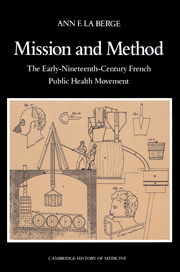Book contents
Introduction
Published online by Cambridge University Press: 17 September 2009
Summary
The first organized public health movement, composed of physicians, pharmacist-chemists, engineers, veterinarians, and administrators – all calling themselves hygienists – organized in Paris around the journal Annales d'hygiène publique and the Paris health council. Although the hygiene movement had no one leader comparable to Edwin Chadwick, the two most influential hygienists were Louis-René Villermé and Alexandre Parent-Duchâtelet.
The French public health movement was born and developed within the sociopolitical context of the Bourbon Restoration and the July Monarchy, with their national public health policies and programs, some of which were inherited from the Ancien Régime and the Revolutionary and Napoleonic eras. Several national health institutions and programs were already in place by the 1820s, when the movement began to coalesce. The Royal Academy of Medicine, for example, was founded in 1820 to replace the defunct Royal Society of Medicine, but it continued the traditions of its predecessor, whose interests focused on epidemics.
The public health movement also developed within the context of competing ideologies: liberalism, conservatism, socialism, and statism – all of them tracing their roots to the Ancien Régime and the Revolution. For the public health movement the two dominant ideologies were liberalism and statism. Liberalism was the political persuasion of the leaders of the July Monarchy, and many hygienists operated within the liberal framework, believing most reform was best handled at the individual level and that only limited state intervention to preserve the public health was justified.
- Type
- Chapter
- Information
- Mission and MethodThe Early Nineteenth-Century French Public Health Movement, pp. 1 - 6Publisher: Cambridge University PressPrint publication year: 1992

